Some digital resources may be temporarily unavailable due to maintenance.
“What’s your KC Q” is a joint project of the Kansas City Public Library and The Kansas City Star. Readers submit questions, the public votes on which questions to answer, and our team of librarians and reporters dig deep to uncover the answers.
Have a question you want to ask? Submit it now »
by Maxwell Adler | madler@kcstar.com
Terrence O’Malley remembers a time when the Mafia’s footprint was all over Kansas City. Historians quip that the mafia once owned everything — even “the stones in the ground.”
In 1968, when O’ Malley — the author of Black Hand Strawman: The History of Organized Crime in Kansas City — was a child, he was sitting shotgun in his father’s car as the two of them drove past Antonio’s on 43rd and Main streets.
“[My father] goes, ‘that’s a mafia hangout.’ And I was like, man, what the hell?” O’Malley said. “I had no idea as a 10-year-old kid, but, it was just known in the city that there was this criminal underworld — this subculture called the mob.”
Contrary to the historical treatment given to a majority of violent criminals, mob stories are often romanticized, passed down from one generation to the next — and glorified.
Much of the reason for this can be traced back to Prohibition. Organized criminals were heralded as heroes, standing against the hugely unpopular Volstead Act.
Even as time puts distance between the present and early 20th century mobsters, the public’s interest in these men hasn’t waned.
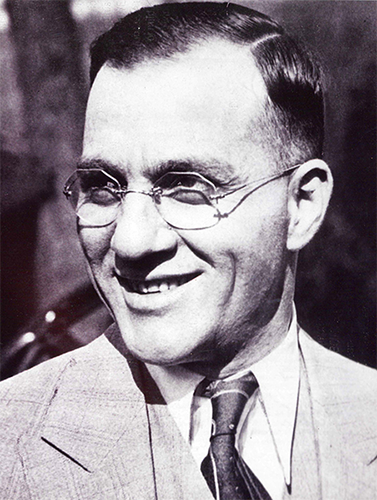
A reader recently asked ”What’s your KCQ?,” a community reference project with The Star and the Kansas City Public Library, about the early days of the Kansas City Mafia: “Who was leader of the Kansas City mafia during Prohibition?”
To answer the question, we took a deep dive into records kept by the library, particularly their recently published “Organized Crime Files” archive. We also talked to crime experts and historians.
The Kansas City mafia’s rise to national prominence
In May of 1929, a corrupt New Jersey politician named Enoch Johnson (the real-life inspiration for the character Nucky Thompson in “Boardwalk Empire”), hosted America’s most notorious career criminals in his hometown of Atlantic City. The meeting of mobsters is considered to have been the first organized crime summit in U.S. history. It also was one of the first times that Jewish, Italian and Irish criminals came together in unison, mutually forming governing principles. Attendees included the likes of Al Capone, Lucky Luciano, Meyer Lansky and Kansas City’s own, John Lazia.
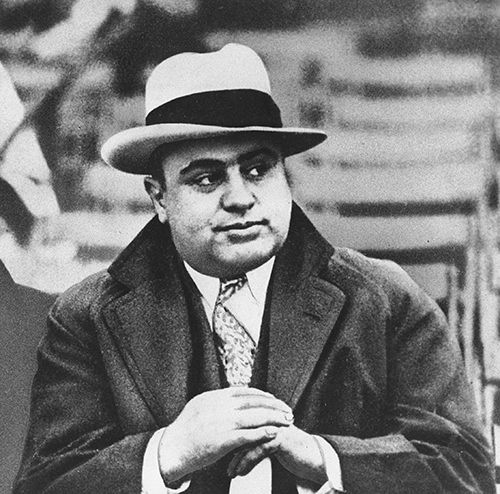
Sixty years after Capone’s death, the world’s most famous gangster still draws a crowd in Chicago and
visitors from all over the world come to search for anything Capone, who died Jan. 25, 1947. | AP
The Atlantic City Conference’s organizers called the meeting during an inflection point for mobsters in the United States. The federal alcohol ban brought organized criminals more wealth than any of Prohibition’s champions could have imagined. Suddenly, the criminal underworld was able to provide a product that legitimate establishments could no longer serve. Consequently, regional bootlegging outfits were getting into territorial disputes with one another as their businesses grew larger and more profitable.
Lazia’s presence at the Atlantic City Conference was indicative of the earning power and political influence held by the Kansas City Mafia at the time. By 1929, organized crime in Kansas City was becoming, well ... more organized.
The two men responsible for shaping the criminal underworld were Lazia and none other than Tom Pendergast. While the mob might have controlled the North End, Pendergast controlled all of the Kansas City metro by wielding his unchecked political power as Missouri’s most prominent Democrat, and through his control of Missouri’s federal relief welfare program.
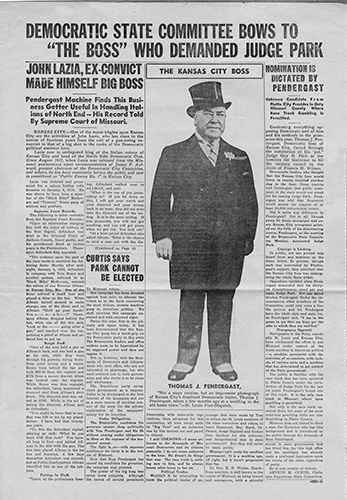
Unknown Republican publication without volume or issue identification with excerpts from several St. Louis newspapers about the corrupting influence of Tom Pendergast in Kansas City, including the accusation that he chose the Democratic nominee for Governor. Crimes committed by Johnny Lazia and others are also described. | Jackson County Historical Society
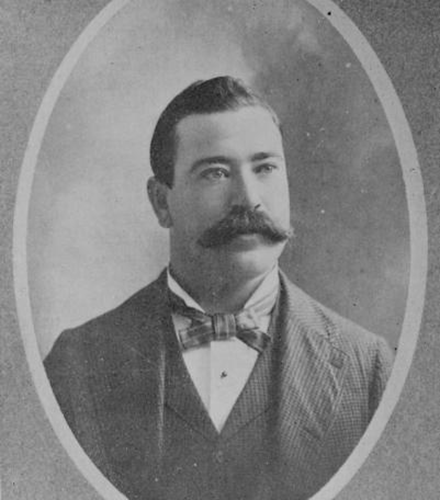
Like Atlantic City, 1920s Kansas City had a reputation for being a wide open town, where illegal vice and corruption flourished. Pendergast’s corrupt political machine turned a blind eye to the gambling, extortion and bootlegging enterprises that were thriving within city limits. O’Malley said Kansas City authorities did not make one single alcohol-related felony arrest during all of Prohibition.
“The mob sponsored a lot of fun in Kansas City,” O’Malley said. “Kansas City had one of the best mobs in the country.”
In exchange for turning out the vote in the majority-Italian North End, the Pendergast political machine gave free reign to Lazia and other mafioso. Consequently, Kansas City’s voter turnout was suspiciously high during the Pendergast era — sometimes surpassing the number of registered voters. The mob would ride around town on election day and make sure people voted for the Democrats whom Pendergast had endorsed.
Pendergast’s allies in the Democratic Party amassed a mountain of political, economic and social influence within the city. With “Boss Tom” at his side, Lazia climbed the criminal ranks and began ascending higher on the socioeconomic ladder.
Lazia: From Brooklyn to Kansas City
Mob influence first took hold in Kansas City around the turn of the 20th century, when an influx of Sicllian citizens arrived in major cities lining the Mississippi River System. Many were looking for job opportunities in America’s burgeoning railroad industry. Others, stymied by a lack of employment, resorted to crime as a means to survive.
The first prominent criminal outfit in Kansas City was called the Black Hand. It was a sinister extortion racket that operated out of Kansas City’s North End. Blackhanders — a name they were given because of their proclivity for leaving threatening notes adorned with a black handprint— would approach their fellow Italian immigrants in Kansas City with the following proposition: “pay or die.” While there are infamous criminals, like the DiGiovanni Brothers, who were closely associated with the Black Hand era, there was not a de facto leader of the criminal underworld in Kansas City during this time. In fact, there was little unity among the different criminal gangs. This environment was primed for an ambitious hustler, like Lazia, to bring all the criminals together under a shared vision.
Lazia was born in Brooklyn in 1896 and later moved to Missouri. As a teenager in Kansas City, Lazia ran with a group known as “Black Mike” McGovern’s gang. Lazia’s gang of fellow Sicilian boys perpetrated a variety of petty-crimes in the Little Italy neighborhood near the City Market. In 1913, when he was 16 years old, Lazia was shot through the shoulder by a policeman while he was attempting to steal eggs from a produce dealer on Fourth Street. Lazia fled town for a brief period following the shooting.
When he returned, Lazia jumped right back into criminal life. Despite Lazia’s close association with the North Side, one of his regular hangouts was in the neighborhood around 12th Street and Baltimore Avenue, where large hotels once lined the streets. As early as 1918, he was purportedly serving as the “bank” for a crap game on Baltimore Avenue, directly across from the Hotel Baltimore. In 1922, he ran another game at 220 West 12th Street, behind a shop that sold radios, according to Italian Gardens: A History of Kansas City Through Its Favorite Restaurant, by John David DiCapo and Frank R. Hayde.
In the late teens and early 20s, Lazia advanced quickly through the ranks of the Pendergast machine with the guidance of his Irish-American mentor, Michael Ross. Ross— captain of the 5th Democratic Ward in “Little Italy”— was a close associate of Pendergast.
Lazia’s Power Grab: 1928
In 1928, a power hungry Lazia led a coup d’état against his former mentor. He started campaigning to take control of the North Side 5th Democratic Ward. Lazia began criticizing Ross for moving away from the North Side to an apartment on Armour Boulevard.
“We need a leader who lives among us,” Lazia said, according to library archives. “Not one who comes down here only on election day.”
The coup effectively wrestled away control of the North End and transferred it to Lazia and his Sicilian friends. After successfully ousting Ross, Lazia founded a new North Side Democratic Club.
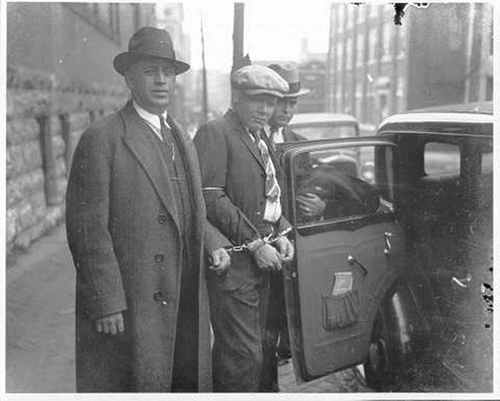
Michael Ross, captain of “Little Italy,” or Kansas City’s North End. | Kansas City Public Library
“Ironically, Lazia eventually moved [out of the North End] to his own Armour Boulevard apartment, outside of which he was shot and killed in 1934,” John Simonson, author of Prohibition in Kansas City, Missouri: Highballs, Spooners & Crooked Dice, said in an email to The Star.
After his success in the 1928 Kansas City municipal elections, Lazia began asserting his newfound political power. Under Lazia, there was now cooperation among Kansas City’s crime organizations. Most of the criminal groups came together to form what was dubbed the “Sugar House Syndicate.” The organization was aptly named after the primary ingredient in alcohol fermentation. It was during these years of the Sugar House Syndicate that Lazia rose to power.
When he became leader of the 5th Democratic Ward, Lazia had an office on the same floor as the Kansas City police chief. Lazia and Pendergast conspired to flood the police department with loyal Democratic allies and former convicts. Lazia went as far as to make sure that the policemen were grossly underpaid, and therefore, more likely to accept bribes, engage in corrupt activities and, ultimately, keep the liquor in Kansas City flowing.
By 1928, more than 100 speakeasies and illegal taverns — serving the city’s throngs of lower and middle class citizens — were operating out of the North End.
“Rich men had their clubs where they go to gamble and drink and smoke, and carry on,” O’Malley said. “So, (Pendergast thought) why shouldn’t the middle-class, or why shouldn’t the poor man have the same opportunity?”
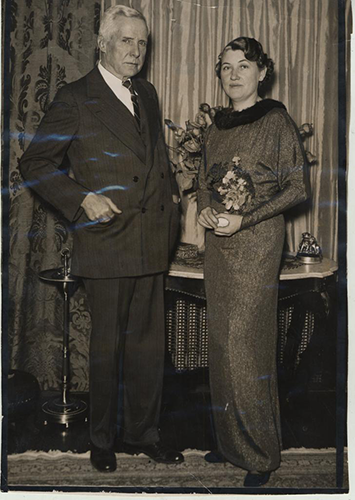
In 1931, at the peak of his political power, Lazia leveraged his criminal ties influence among the police for a good cause. On the evening of Dec. 16, 1931, Nell Donnelly (a.k.a. Nelly Don), a prominent dress manufacturer and wife of former U.S. Senator and Pendergast Ally, James A. Reed, was kidnapped and held for ransom. Lazia put out the word in the criminal underworld that he wanted her released immediately. Within 34 hours, she was freed unharmed, and her captors were on the run.
Lazia’s fall from power
In 1934, Lazia was arrested on charges of federal income tax evasion. Even Pendergast couldn’t help Lazia navigate the federal charges he was now facing. Less than five months after his arrest, while he was out on bail, Lazia was shot by unknown assailants upon returning to his home from the Lake Lotawana area. His wife, who was also present during the attack, escaped unscathed.
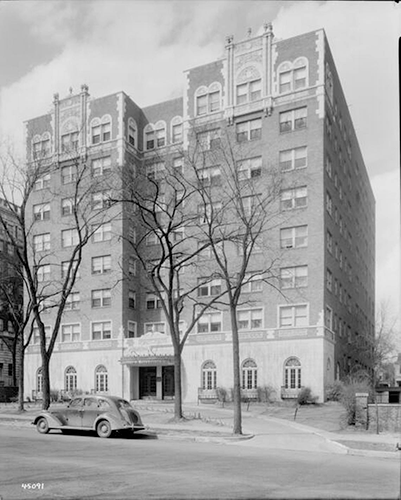
entrance to the building is in view. A car parked on Armour Boulevard can be seen. The structure
was built in 1929 and is part of the Armour/Gillham Historic Apartment-Hotel District | Kansas City Public Library
On his deathbed, Lazia expressed his gratitude for the man who cemented Lazia’s political and economic standing in Kansas City.
“I don’t know why they did it. I am a friend to everybody. I don’t know why they did this to me. If anything happens, notify Tom Pendergast, my best friend, and tell him I love him,” Lazia said.
Lazia died on July 10, 1934. He was 37 years old.
At Lazia’s funeral, he was laid out in a silver-lined copper coffin in the dining room of his sister’s house at the corner of east 55th Street and Tracy Avenue. The funeral’s organizers spent $40,000 on the event and more than 10,000 mourners came and paid their respects that night.
By the time of Lazia’s death, he had brought the Kansas City outfit of the mafia to national prominence. Many lives paid the toll.
Pendergast’s downfall
Shortly after Lazia’s death, Pendergast, would also meet his downfall at the hands of the federal government.
In 1939, Pendergast was indicted for tax evasion and sentenced to 15 months in prison. He served his sentence at Leavenworth Penitentiary.
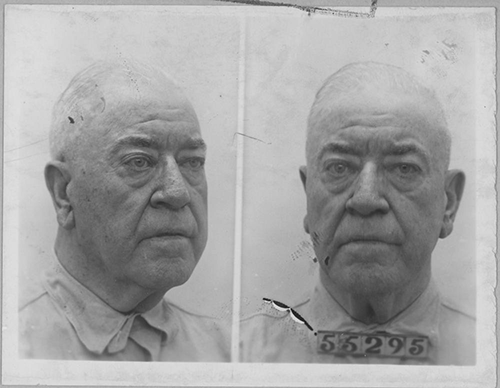
conditional release from prison on May 30, 1940 | National Archives at College Park
After serving 12 months, he was released on the condition that he have no future involvement in political affairs. Pendergast proceeded to dive head first into his gambling addiction. Fed up with her husband’s dissent into darkness, Pendergast’s wife, Caroline, moved out of their family home shortly following his return from Leavenworth.
Pendergast died of heart failure on Jan. 26, 1945, at the age of 72.
Lazia and Pendergast have been cemented in Kansas City lore. Their lives, and the lives of the successors, served as inspiration for the critically acclaimed fourth season of FX’s “Fargo,” set in 1950s Kansas City. This latest season of the FX show — loosely based on the Coen Brothers 1995 film — explores Italian and Irish immigration, the “Great Migration” from the Jim Crow south, and assimilation in the 20th century Midwest.
Read more about Kansas City organized crime and the Pendergast years at pendergastkc.org. Access the “Organized Crime Files” kclibrary.org.
Submit a Question
Do you want to ask a question for a future voting round? Kansas City Star reporters and Kansas City Public Library researchers will investigate the question and explain how we got the answer. Enter it below to get started.
